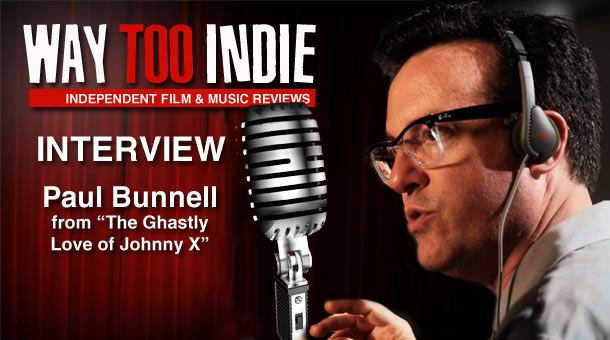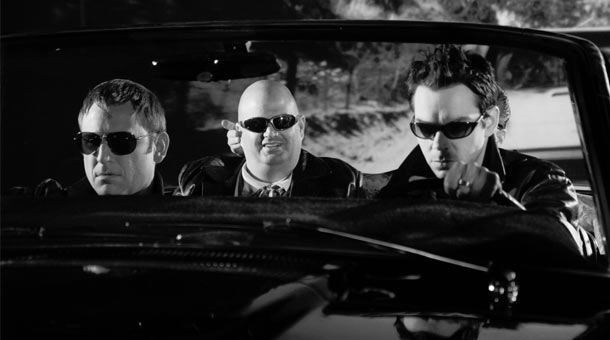Interview: Paul Bunnell – The Ghastly Love of Johnny X

I had a lot of memorable experiences at this year’s SF Indiefest, but the screening of director Paul Bunnell’s The Ghastly Love of Johnny X has to be right up at the top of the list. I was greeted at the box office by a camera crew (which I would later learn was shooting a piece for CBS) and Bunnell himself, who was full of enthusiasm and excitement about introducing the film to fresh eyes. The movie was presented in 35mm, and there were some projection issues in the middle of the film (the image completely blacked out at one point), but these technical hiccups only served to make the night more unforgettable. It reminded me that I was watching film, not a plastic disc. I’ll take imperfection over sterility every time.
Read our review of The Ghastly Love of Johnny X
Mr. Bunnell was generous enough to give Way Too Indie an interview about his wacky sci-fi adventure. He offers insight into the history of the film, his filmmaking process, his inspirations, the benefits of shooting on film, and much more.
The Ghastly Love of Johnny X is one of the strangest, scatterbrained films you’d have the pleasure of watching this year, and even Bunnell, the creator of the erratic comedy, had trouble summing it up into a sound bite.
“You can’t really put it into one sentence, but I’d say it’s about a gang of juvenile delinquents from outer space…and their gang leader (Johnny X) gets sentenced to planet earth for general mischievousness until Johnny can do a good deed. You know, I’ll tell you, it’s so crazy, it’s hard to really sum up into a sentence. I’d like to call it the only sci-fi/horror/comedy/intergalactic/weird movie you need to see this year…I don’t know, it’s just kind of a strange film. Good luck trying to sum it up! I usually say ‘The movie’s 106 minutes. Just come on in, go with it, and don’t have any expectations. It is what it is, (so just) go along for the ride and have a good time.”
Johnny X is full of greasers, classic cars, and soda shops, indicating influences from 50s and 60s culture and cinema. While Bunnell set out to make a nostalgic film, he was careful to not veer into ‘spoof’ territory.
“I was influenced by movies…from the 50’s and 60’s. A lot of the juvenile delinquent, teenage angst type films…like The Wild One with Marlon Brando to East of Eden (with) James Dean, to sci-fi films like Teenagers From Outer Space. Genre stuff like The Good the Bad and the Ugly. I wasn’t trying to make one of those films necessarily; I just wanted the look and feel of (them.)”
Initially, what surprised me about the film were its atypically high production values (the posters make it look like a B-movie.) Bunnell discusses the importance of making the film look as polished as possible.
“I didn’t want to compromise on the quality (of the film), which is why I had to wait to get the movie finished. A lot of friends said ‘Hey, you shot part of the film, why don’t you just go ahead and finish it up as a short film, shoot it (digitally), or make some kind of director’s reel out of it’, but I really didn’t want to do that. I knew I had to go for broke. I took the extra time and headache(s) to get (the film) looking, feeling, and sounding like a bigger movie, something contemporary. I felt like if I wasn’t going to do that, then what’s the point? I think audiences today expect a movie to be well done. They can certainly smell a cheap movie.”

It was truly a joy to watch such a retro-stylized movie projected in 35mm in the historic Roxie Theater. The flicker and life only film can achieve made this screening one of the purest movie-going experiences I’ve had in a while. Bunnell described the significance of film to his work.
“When I was a kid, I started out shooting on super 8 film…graduated to 16mm, and (Johnny X) was my first 35mm production. When I was a kid, 35mm was the thing to do. During the making of (Johnny X), everything started shifting over to digital, but I still wanted to finish it on film because I feel that film delivers something (organic) that you still cannot quite replicate (digitally.) The bottom line for me is the story. If you’ve got a good story, it doesn’t really matter what you shoot it on.”
Alfred Hitchcock mourned the silent film era when the first ‘talkies’ began to overrun cinemas in the 1920s. I asked Mr. Bunnell if he felt the same sadness for the passing of the film era into the digital era.
“I do (mourn the film age.) I’m so used to seeing (film) and what it looks like. (Film) is a really magical medium. It’s an over 100-year-old process. When (you’re) working with film, you have to be very, very careful about what you’re shooting, how you shoot it. (Everything has to be) very thought-out, and the plan has to be in place. With digital, you can roll and roll and roll, and you don’t have to worry about it. Well, we’re burning up film here! It really takes discipline. With digital cinema, there’s a lack of discipline with some filmmakers, because I don’t think they know (discipline.) When I’m shooting, I know exactly what I want to do. I get my angles, my shots, I rehearse the scenes, because (I) don’t have a lot of time or money to burn. It’s a technique that is going away with younger filmmakers.
There’s something about getting film exposed, taking it to the lab, developing it, then watching it when it’s projected…there’s something magical (about that experience) for me.”
Bunnell discusses these topics and much more, like the 10 year process of making Johnny X, his talented cast, how a carbon arc projector works, his choice to film on the now extinct Kodak Plus-X film stock, and much more in the full interview, which you can listen to in its entirety below.
